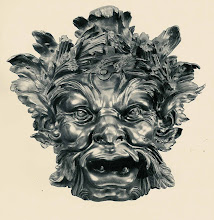Saturday, January 29, 2011
Louis XV Coiffeuse Armchair
Monday, January 24, 2011
Winter Antiques Show Highlights
 Here is a pair of fountain-head sculptural masks listed as being from Chateau du Fontainebleau in the booth of the London-based deal, Daniel Katz, Ltd. Wonderful detail. Reminded me of our own, latter, bronze mask that you may recognize as our main image on Facebook.
Here is a pair of fountain-head sculptural masks listed as being from Chateau du Fontainebleau in the booth of the London-based deal, Daniel Katz, Ltd. Wonderful detail. Reminded me of our own, latter, bronze mask that you may recognize as our main image on Facebook. This is the booth of NYC-based dealer Jim Elkins and Lost City Arts. In the front center there is a great, rare sculpture by Paul Evans, from very early in his career.
This is the booth of NYC-based dealer Jim Elkins and Lost City Arts. In the front center there is a great, rare sculpture by Paul Evans, from very early in his career.
This really speaks for itself. A striking late Art Deco French lounge chair in the booth of NYC-based dealer Carolle Thibaut-Pomerantz.
The show runs through January 30th.
Monday, January 10, 2011
Trade Tips 5: Upholstery Trim
Monday, January 3, 2011
Notes for 2011
The last few weeks of 2010, as I try and think about what we might expect from 2011, reading the headlines alternating between recovery and recession themed stories has been frustrating. For every legitimate story evidencing the nascent recovery, there is at least one or more that cause me to pause. Most recently, the holiday shopping period was generally considered successful and stronger than last year, but how much of this was due to steep discounting is hard to tell. Is this really a sign of economic strength or is it an illusion created by significantly reduced prices?
There are some encouraging metrics that support the recovery side of the debate. As of October, disposable income and personal consumption were both up slightly less than 4% year on year, and consumption of durable goods was up 8.5% year on year (according to the Bureau for Economic Analysis). All this while inflation is hovering around 1%. Consumers are also continuing to reduce their overall debt levels.
But on the negative side of the ledger, there is relatively high unemployment, which no one expects to substantially improve any time soon; relatively tight credit; and seemingly no pricing power. So we have something happening that intuitively is not what you’d typically expect: significant areas of weakness along with pockets of legitimate strength, sometimes in areas that you would expect to be dragged down by that same weakness.
Discounting has been especially interesting in the luxury market. Technology and mobile phones have made price information and comparison a reality and sites like Gilt and One Kings Lane have made high priced luxury goods available at bargain prices. Both of these trends have helped blur the line between luxury and ordinary. So if luxe and ordinary goods are closely priced, are mass market consumers “trading up” while luxe goods are “trading down”? I am betting that when anybody gets a luxe good at discount they still feel like they got a “deal” and value for their money.
That people are more careful with their money today is a foregone conclusion. But that does not mean they are not spending it. In fact, spending on “luxury goods” is at or above pre-Recession levels based on studies by American Express and Bain & Co (stories here: http://www.luxurydaily.com/luxury-sector-sales-rebound-to-historic-high-of-2007-bain/ and http://www.luxurydaily.com/luxury-spending-higher-than-pre-recession-levels-american-express/ )
So just like in the broader economy, we have a bifurcation taking place between strength and weakness, or in this case “true” luxury goods and discounted or mass market goods where luxury goods that can establish their authenticity and value actually have some degree of pricing power. The difference now is people need to understand the value behind a good versus the branded image it is trying to portray. More like an informed and discerning demand vs. conspicuous consumption.
When prices between luxury and ordinary goods are blurred and both high-end and mass market consumers are justifiably taking advantage of discount pricing, the way for a luxury good or service to set itself apart will be to clearly establish its superior quality and originality. If price does not set a luxury good or service apart from their mass market counterparts, then what does? The intense creative development process and an uncompromising attention to detail and quality.
Ironically, how companies convey this will be thru the same medium that this shift to quality is moving away from – the brand. However, instead of the superficial, carefully manufactured brand of the 1990’s, companies will need to let clients into the creative process so that they can see the brand is an accurate reflection of what the company produces. If you want to be associated with quality and authenticity, then clients need to see this in what goes into making their good and throughout their experience with you. Thankfully, the same technology that has made price comparison so easy makes other types of information also available, including information to help them discern luxury versus ordinary.
So, how are we preparing for 2011?
We plan to reinforce our attention to our clients and their experience with us from the first phone call or web visit, through development, and after their purchase or project is complete.
We plan to continue with introducing our own in-house line of limited edition pieces and signature items.
We will continue and broaden our efforts to illustrate to clients our development process and the craftsmanship and level of detail that we put into our pieces.




